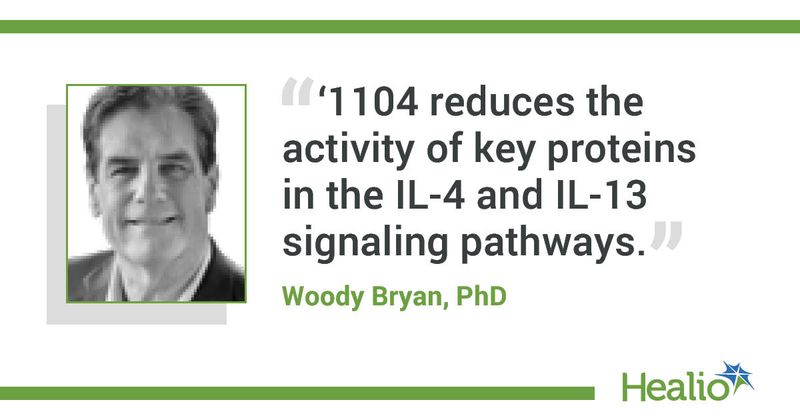Peptide’s upstream mechanisms of action validated in allergy treatment
Key takeaways:
- Current allergy therapies target inflammation downstream.
- Revolo Biotherapeutics’ ‘1104 peptide binds to antigen-presenting cells upstream.
- The company is developing subcutaneous administration of ‘1104.
A novel peptide that uniquely affects the effector and regulatory arms of immune responses has potential for treating eosinophilic esophagitis and other allergic diseases, according to a press release from Revolo Biotherapeutics.
Known as ‘1104, the first-in-class peptide uses selective upstream binding to allergic antigen-presenting cells to bind to a novel receptor, reducing IL-4 and IL-13 signaling pathways, the company said.

“Most allergic disease treatments such as corticosteroids, antihistamines or biologic therapies are limited by a downstream mechanism of action that addresses inflammation after it has already occurred,” Woody Bryan, PhD, CEO of Revolo, told Healio.
These treatments have inadequate and variable long-term efficacy with low rates of disease remission as a result, Bryan continued, requiring regular administration. Also, he added, regular corticosteroid use can result in serious adverse events as well.
Instead, ‘1104 works upstream of the inflammatory cascade, Bryan said.
“Current downstream approaches only impact certain elements of the effector arm and have no impact on the regulatory arm,” he said.
The new peptide binds to a novel surface cell receptor on allergic antigen-presenting cells, which Bryan said were key to the immune response.
“By binding to this receptor, ‘1104 reduces the activity of key proteins in the IL-4 and IL-13 signaling pathways, which are involved in inflammation,” he said. “This is achieved by activating SHP-1, a molecule that helps turn off these inflammatory signals.”
Bryan further said that ‘1104 quickly increases the number of activated T and B regulatory cells, which suppress inflammatory immune responses.
For example, previous research found that an 8 mg dose of ‘1104 yielded an approximately 58% increase in T regulatory cells, with all patients also seeing an increase in CD95+IgD-CD27highCD38high(gated on CD3-CD19+) B regulatory cells.
There was a 14% reduction in CD4+ cells and a 45% reduction in CD8+ cells, which Revolo called key inflammatory cells in EoE, as well. The company also called all these findings statistically significant.
”This unique dual action helps balance the immune system and avoid inflammation by affecting both the effector and regulatory arms of the immune response,” Bryan said.
Revolo also said that these T regulatory and B regulatory cells remain activated for multiple weeks, restoring immune homeostasis and supporting dosing regimens that are less frequent.
The previously completed clinical trials and new data from preclinical studies demonstrate the peptide’s potential for treating a range of allergic diseases, the company said.
A phase 2a clinical trial of the efficacy, safety and tolerability of ‘1104 among adults with active EoE found statistically significant separation from baseline in key clinical endpoints as well as rapid translation into a clinical response based on patient-reported outcomes on the Dysphagia Severity Questionnaire, the company said.
These findings indicate that the peptide’s upstream mechanism of action offers a first-in-class modality that overcomes the shortfalls of other downstream approaches that have impacted histologic endpoints without showing clinical response, Revolo continued.
In another phase 2a trial mapping study, individuals with allergies who participated in nasal and skin allergen challenges experienced rapid reductions in intradermal allergic inflammation on the first day of treatment with ‘1104, the company said.
The sustained activation of T regulatory and B regulatory cells further validated this mechanism of action with persistence through 28 days and longer, Revolo said.
Preclinical studies of a subcutaneous (SC) dosage form of ‘1104 yielded additional positive animal data that verified the continued development of a differentiated commercial formulation, Revolo said.
“Current downstream allergy medicines are predominantly administered via SC injection,” Bryan said.
These new data verify the potential for SC therapy, he continued, which would provide greater convenience for patients.
“We are also working on advancing a sublingual formulation, which will further improve the product profile for patients living with these chronic diseases,” he said.
SC delivery of ‘1104 also performed as well as intravenous administration in animal models of allergic disease, Revolo added, noting that these new data also validate its prioritization of its SC development program.
The company plans on initiating bridging clinical studies in 2025 as well as additional phase 2 studies next year to further evaluate the peptide’s use in treating EoE, following a previous phase 2a study with promising efficacy and safety data.
“The trial will include a first part evaluating higher doses of ‘1104 intravenously, transitioning into a second part evaluating its subcutaneous administration,” Bryan said. “In parallel, we plan to run a proof-of-concept trial with ‘1104 in a second allergic disease, while continuing to validate the sublingual formulation of ‘1104 in preclinical studies.”
Reference:
- Revolo Biotherapeutics announces additional data from phase 2A trial of ‘1104 in adults with active eosinophilic esophagitis. https://revolobio.com/2023/07/18/revolo-biotherapeutics-announces-additional-data-from-phase-2a-trial-of-1104-in-adults-with-active-eosinophilic-esophagitis/. Published July 18, 2023. Accessed July 30, 2024.
